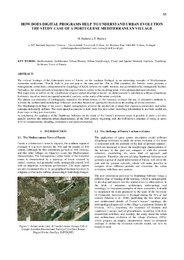How Does Digital Programs Help to Understand Urban Evolution the Study Case of a Portuguese Mediterranean Village
Abstract
The cultural heritage of the fisherman's town of Fuseta, on the southern Portugal, is an interesting example of Mediterranean vernacular architecture. Totally built in just one-step at the turn and the 19th to 20th centuries, the historic centre presents a homogeneous urban fabric characterized by a typology of house covered by vaults' terraces, and pyramidal roofs, strategically located. Nowadays, the urban network extrapolates the original historic centre to the involving areas, with a demarcated rural structure. This paper aims to reflect on the contribution of space syntax descriptive model, an alpha numeric's calculation software (Depthmap Software), based on visual and spatial networks' analysis, to the study of the urban evolution. The almost non-existence of bibliography related to the urban history of this territory, enforces the use of alternative methods to increase the architectural morphology's theories and other theoretical approaches focused on the reading of urban territories. The Depthmap modelling of the town's digital cartographics allowed the production of maps that expresses parameters and urban concepts universally defined. The main question consists in how deep this new urban modelling information is and how useful are these maps or they just descriptive. In conclusion, the appliance of the Depthmap Software on the study of the Fuseta's urbanism made it possible to draw a reliable parallel between the unknown urban characteristics of the 20th century beginning with the well-known structure of today, at same level of measurements, detailing, information and parameterization.
Collections
- Συνέδριο Euromed [68]
